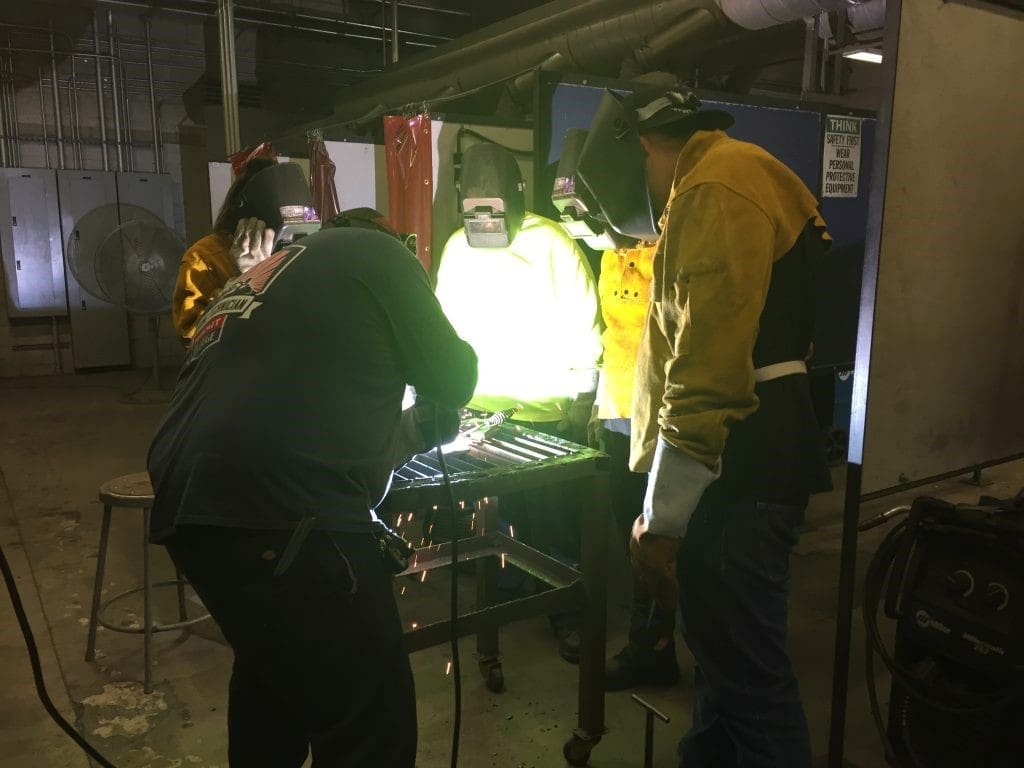Are you ready to launch an exciting career as a welder? This in-demand industry allows you to work with your hands to create and repair a wide range of metallic components. Just what is welding? Find out today and learn more about starting your career as a welder in California or throughout the country.
Welding Defined
Welding is a dependable way to join two pieces of metal.
This basic process can be done in lots of ways, but at its heart welding is about connecting pieces of metal.
This process requires heat and pressure. A welder uses an electric or gas flame to create intense heat to soften a piece of metal or a metal joint compound. Pressure is applied and two pieces of metal are connected together. Once cooled, the piece is now one with a sturdy joint.
Welding is often used when it isn’t practical to connect two pieces of metal in another way. Rivets, screws, and other fasteners don’t create an airtight seal. They can also cost more and only be used in certain joint types. A weld is a firm joint style that can be used in a variety of ways. As a career, welding combines creating thinking, problem-solving and hands-on skills for a daily job that’s full of excitement and growth opportunities.
The Welding Process
You may be surprised at the number of ways two pieces of metal can be connected. Welding is used in virtually every industry, so welders need to be creative in choosing the right welding type and joint style. Here are some common ways to join two pieces together:
- Edge joint
- T joint
- Corner joint
- Lap joint
- Butt joint
A welder chooses the type of joint after carefully considering the materials and application. Does the material need to withstand heavy sheer loads or torsional loads? This can affect the best type of joint and which weld type is used.
Some welding jobs require you to use your problem-solving skills. Would an edge joint or T joint be better for this application? What’s the best filler material and inert gas for this particular application?
Once you have the skills, experiences, and resources from a quality training program, you can easily answer these questions to create secure products for your industry.

Types of Welds
All types of welds can be divided into two categories: pressure welding and fusion welding. Pressure welding uses heavy pressure at or above the melting point of the base material. Fusion welding focuses heat at the edge of the material and doesn’t require external pressure. Many fusion welds use an inert gas to improve the strength and other features of the weld.
At Summit College El Cajon, students learn about the most common welding tools, safety gear, and weld styles. You’ll now only learn about these common styles but get a chance to try your hand at welding in real-world applications. Here are the most common welding styles used:
- Gas tungsten arc
- Shielded-metal arc
- Flux-cored arc
- Gas metal arc
- Plasma arc
- Electron-beam
- Laser beam
- Electroslag
- Atomic hydrogen welding
These nine varieties can be divided into three categories: friction, arc, and electron beam. Friction welding uses mechanical friction and can be used even for wood and aluminum applications. It doesn’t use filler metals or requires a shielding gas, so it’s being used in various industries to firmly bond wood and lightweight aluminum products.
Arc welding is the most popular and familiar style. Whether you pick up a manual, automatic, or semi-automatic welder, it’s important to learn how to create successful joints with an arc welder. TIG, MIG, GTAW, and other common welding styles all fall under this category.
A high-tech welding style is laser welding. This style is commonly automated and used for deep welds. Electron beam welding requires a vacuum, while laser beam welders can be used in air.
Common Applications
Becoming a welder is an exciting way to dive into an essential industry and create cutting-edge mechanical and electronic devices. Prospective welders can enjoy a career in one of these industries:
- Automotive
- Aerospace
- Construction
- Energy
- Art
While much of the automotive manufacturing process is automated, skilled welders are still required for precise tasks, repair projects, and custom-made vehicles. Try your hand at welding a chassis, replacing a body panel, or performing other duties to prepare a vehicle for its first ride.
Airplanes require lightweight components and flawless welds to pass safety standards before taking to the skies. Use innovative welding practices to join lightweight aluminum components. Work side-by-side with engineers to create a private, military, or commercial plane.
Commercial buildings use steel beams and other components to soar above wood construction projects. Try your hand at welding on the construction site to watch a skyscraper or high-rise office become a reality before your eyes.
The energy sector needs welders to fix pipelines, construct well shafts, and finish lithium-ion batteries. Work with a leading oil and gas company or help promote renewable energies by constructing green energy alternatives. Working in the energy sector may give you the opportunity to travel to remote workplaces to repair and install key components around the country.
Finally, some welders are using their technical skills to create artwork for their local community. Create stunning statues and inspiring murals out of steel components.
Welding can complement other artistic mediums or create stand-alone artwork.
Start Your Welding Career at Summit College
So, how does welding work? If you’re ready to learn more about this practical and highly sought skill, it’s time to head to Summit College. Launch a career in automotive, renewable energy, or construction today by enrolling in a welding program at El Cajon, California.
Learn about gas metal arc welding, SMAW pipe fitting and layout, and other key welding skills before applying for jobs in your area or around the country. Learn more about our welding program at Summit College to discover a great way to expand your skills or start a new career. Work with small classes, dedicated instructors, and cutting-edge course work to spark your interest in welding for various industries.
Tags: weld, Welder, Welding, welding program, welding types



